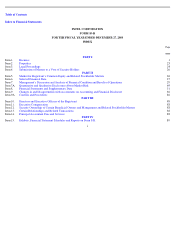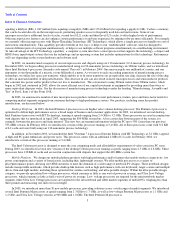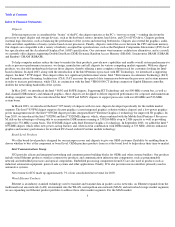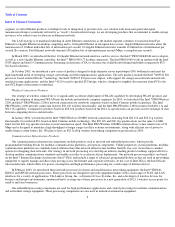Intel 2003 Annual Report Download - page 12
Download and view the complete annual report
Please find page 12 of the 2003 Intel annual report below. You can navigate through the pages in the report by either clicking on the pages listed below, or by using the keyword search tool below to find specific information within the annual report.
Table of Contents
Index to Financial Statements
We also began manufacturing microprocessors on our most advanced 90-nanometer (a nanometer is one billionth of a meter) process
technology, the next generation beyond our 130-nanometer (0.13-micron) process technology. The 90-nanometer process technology is our
most advanced high-volume production process featuring structures smaller than the size of a virus, the smallest microorganism. As we move
to each succeeding generation of manufacturing process technology, we utilize less space per transistor, which enables us to put more
transistors on an equivalent size chip, decrease the size of the chip or offer an increased number of integrated features, which can result in faster
microprocessors, products that consume less power and/or products that cost less to manufacture. As of year-end 2003, the majority of our
microprocessors and chipsets were manufactured using our 130-nanometer process technology.
We manufacture flash memory using our 130-
nanometer process technology primarily in New Mexico, and also in Ireland and California.
We also manufacture flash memory in Colorado using our 180-nanometer (0.18-micron) technology.
We manufacture microprocessor- and networking-related board-level products, primarily in Malaysia and California. We also use
subcontractors to manufacture some board-level products and systems, and purchase certain communications networking products from
external vendors, primarily in the Asia-Pacific region.
We perform a substantial majority of our components assembly and test at facilities in Malaysia, the Philippines, Costa Rica and China.
In the third quarter of 2003, we announced plans to begin construction on an additional assembly and test facility in Chengdu, China. We plan
to continue to invest in new assembly and test technologies and facilities to keep pace with our microprocessor, chipset and flash technology
improvements. To augment capacity in the U.S. as well as internationally, we use subcontractors to perform assembly of certain products,
primarily flash memory, chipsets, and networking and communications products, as well as third-party manufacturing services (foundries) to
manufacture wafers for certain components, including networking and communications products. Our performance expectations for business
integrity; ethics; environmental, health and safety compliance; and employment practices are the same regardless of whether our supplier and
subcontractor operations are based in the U.S. or elsewhere.
We have thousands of suppliers, including subcontractors, providing our various materials and service needs. We set expectations for
supplier performance and reinforce those expectations with periodic assessments. We communicate those expectations to our suppliers
regularly and work with them to implement improvements when necessary. We seek, where possible, to have several sources of supply for all
of these materials and resources, but we may rely on a single or limited number of suppliers, or upon suppliers in a single country. In those
cases, we develop and implement plans and actions to reduce the exposure that would result from a disruption in supply. We also typically have
multiple factories at various sites around the world producing our products. However, some products are produced in only one factory, and
again we seek, through other actions and plans, to reduce the exposure that would result from a disruption at that factory.
Manufacturing of integrated circuits is a complex process. Normal manufacturing risks include errors and interruptions in the production
process, defects in raw materials and disruptions at suppliers, as well as other risks, all of which can affect the timing of the manufacturing
ramp and yields. A substantial decrease in yields would result in higher manufacturing costs and the possibility of not being able to produce
sufficient volume to meet specific product demand.
We operate globally, with sales offices and research and development activities, as well as manufacturing and assembly and
test facilities,
in many countries, so we are subject to risks and factors associated with doing business outside the U.S. Global operations involve inherent
risks that include currency controls and fluctuations, tariff and import regulations, and regulatory requirements that may limit our or our
customers’ ability to manufacture, assemble and test, design, develop or sell products in particular countries. As part of our site-selection due
diligence processes, we employ assessments of several criteria, which include the property’s physical characteristics or constructability, local
utility infrastructure, transportation capability, availability of technical workforce, construction and supplier capabilities, permitting
requirements and investment conditions. Employment practices and labor rights issues are incorporated in the diligence. Evaluations also
include ratings for security concerns, which include corruption, terrorism, crime and political instability. Security concerns alone are sufficient
to remove projects from consideration. Regardless of these efforts, if terrorist activity, armed conflict, civil or military unrest, or political
instability occurs in the U.S., Israel or other locations, such events may disrupt production, logistics, security and communications, and could
also result in reduced demand for Intel’s products. The impact of major health concerns, or of large-scale outages or interruptions of service
from utility or other infrastructure providers, on Intel, its suppliers, customers or other third parties could also adversely affect our business and
impact customer order patterns. We could also be affected if labor issues disrupt our transportation arrangements or those of our customers or
suppliers. On a worldwide basis, we regularly review our key infrastructure, systems, services and suppliers both internally and externally, to
seek to identify significant vulnerabilities as well as areas of potential business impact if a disruptive event were to occur. Once they are
identified, we assess the risks, and as we consider them to be appropriate, we initiate actions intended to reduce the risks and their potential
impact. However, there can be no assurance that we have identified all significant risks or that we can mitigate all identified risks with
reasonable effort.
9
























